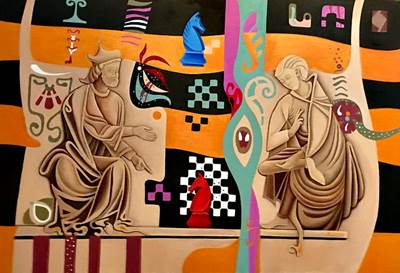Medieval Figures Analyze Modern Theory
For this month's edition of Flickr (Not) Friday, I had a tough choice among another intriguing example of an AI chess image (as in Not so Flickrless Friday earlier this year), an unidentified chess set priced in the stratosphere, or a series of images like the one shown below. For the other choices see 'Flickr Favorites' in the right sidebar (although you might have to scroll if you're reading this long after the date of the post.)

Alphonso teaches Bronstein
© Flickr user Sofia Eulgem under
Creative Commons.
The full title of the Flickr image is 'Alphonso teaches Bronstein, Nicolas Sphicas, Museum of Byzantine Culture, 27/6/2018-2/9/2018; Thessaloniki, Greece', and is one of several images with the same title. One paragraph of the the description says,
The artist is inspired by the medieval figures of the “Book of Games” (Libro de ajedrez, dados, y tablas, 1283) by Alphonso X called the Wise (1221-1284), King of Castile and Leon. The abstract figures are mobilized so as to illustrate the “King’s Indian opening”. It is an opening studied by David Bronstein, a leading chess player of 20th century, which influenced even world chess champions.
The paragraph is from the page “Alphonso teaches Bronstein!” (mbp.gr), where 'mbp' means Museum of Byzantine Culture, Thessaloniki. The page continues,
In the world of Nicolas Sphicas the medieval figures, whose garments reflect the stylish Northern gothic styles, are depicted analyzing the modern chess theory.
The Alphonso X painings were part of my earliest introduction to chess art and to chess history on the web. I wonder how they've evolved through the years.




No comments:
Post a Comment